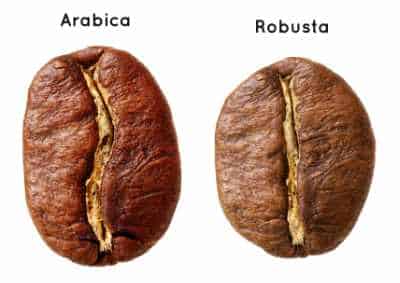There’s nothing quite as satisfying as that first sip of coffee in the morning. Whether it’s an iced coffee on a hot summer’s morning or a bold Italian espresso those delicious flavors and the satisfying buzz is hard to beat.
If you’ve ever spent some time browsing the coffee aisle in your local grocery store or if you’ve had a browse at the bags for sale in your local coffee shop then you may have noticed that these beans are labeled as ‘arabica beans’ or ‘robusta beans’.
What do these terms even mean and do they impact how you enjoy your morning cup of java?
Arabica vs robusta coffee is a simple question with a complex answer. These terms describe different species of coffee that display different characteristics. Arabica beans are sweet and delicate where robusta beans are bold and intense.
If you’re keen to know more about these different types of coffee and where they may have a role to play in your coffee journey then read on. Here’s all you need to know about the coffee beans plus how to select a type of coffee that suits you perfectly.
What Are Arabica and Robusta Coffee Beans?

To start off with, let’s have a look at the actual definition of these terms. I’ll start with the basics to ensure everyone is up to speed! Coffee beans are actually the seed of the coffee plant that has been harvested, processed, and roasted to give them that characteristic brown color. Ground up and stewed in hot water, they release a cacophony of aromas and flavors that give us a delicious cup of coffee.
The coffee plant itself, ‘coffea’ has two varieties that are responsible for the vast majority of the world’s coffee production. These are coffea arabica (which accounts for 60-80% of the world’s coffee) and coffea canephora (which amounts to 20-40%). Coffea canephora is also known as ‘robusta beans’.
How Are They Grown?
Arabica Coffee

Arabica beans are grown at high altitudes. The arabica plants are capable of self-pollination so this makes them a more stable species to maintain as cross-pollination is less likely. This means you’re less likely to lose the advantageous traits that are essential for the coffee’s flavor profile. The downside is they are more vulnerable to pests, fungal infection, and climate change so crops can fail if the growing conditions are poor.
Robusta Coffee
Robusta beans are hardier and can grow at lower altitudes and in higher humidity environments. They contain higher levels of caffeine and acids that are natural pest-repellants. This gives them a survival advantage but too many of these compounds in the beans end up leaving a bitter taste to coffee. Robusta plants need bees and insects to help pollinate them so need a stable ecology to survive.
Single Origin vs Blends
Single-origin coffee beans are beans selected from the same plantation and not mixed with other beans. Arabica coffee beans are typically considered higher-quality so some of the world’s best, specialty coffee are sold as 100% arabica, single-origin.
The downside with single-origin is that the coffee crop can vary throughout the year and you get a compromise in flavor consistency with the changing seasons. For coffee companies that aim to maintain a high product yield then this model won’t work. Blends of coffee beans help balance out flavors and give a rounded taste, no matter when they’re sold.
You can buy 100% arabica blends or 100% robusta blends or even a mix of both. Robusta, being the cheaper beans are sometimes used as a filler ingredient in mixed coffee blends. These beans work well for espresso blends as robusta beans tend to contribute to a better crema.
Taste

The biggest difference between these types of coffee has to be the taste. Arabica beans have delicate fruity, floral flavors with sweeter notes of chocolate and sugar. High-quality robusta beans have more intense, single-note flavors with buttery, nutty, and biscuit notes. Lower-quality robusta beans have a bitter flavor.
Fats
Arabica coffee beans typically have a higher lipid content compared to robusta beans which help contribute towards a more satisfying texture when you brew your coffee. The weird thing is, although you’d expect a higher lipid content to give a better crema when brewing espresso the exact opposite is true. Robusta varieties of coffee actually give a better crema. This is due to the bubbly texture of the fats. You need just the right amount of lipid to keep the crema stable and too much will disrupt the foam. Arabica beans can end up yielding a thin crema due to this.
Acidity
Chlorogenic acid (CGA) is the main health-boosting antioxidant found in coffee beans. Higher levels of this actually protect the coffee plant from pests and diseases and this is true in robusta coffee species. This is what contributes to the bitter taste often found in these beans as arabica coffee typically contains less of these acids so the sweeter flavor notes prevail.
Caffeine Content
Robusta beans win out here with a much higher caffeine content, sometimes double that of arabica beans. This gives you that all-important buzz when you sip on your morning java and some people prefer robusta beans for this reason.
Sugar Content
Arabica beans have a greater sugar content than robusta varieties and this is what gives the sweet and delicate flavors. When these beans come out of the roasters the heat they were subjected to has broken down a lot of the sugars giving more acidic notes to the coffee. This helps bring complexity to the flavor profile and gives arabica that all-important rounded and smooth flavor.
Price
Due to the hardy nature of the robusta species of coffee and their capability to be grown at sea level, these types of coffee beans come in a lot cheaper than arabica ones. This is why they’re often added to coffee blends to reduce the cost.
Uses
Robusta beans, due to their cheap price, are frequently used to make instant coffee powder. This isn’t their only fate however as good quality robusta beans work well for making espresso coffee. The bold, intense flavor is preferred by many coffee drinkers and this quality can stand out well when combined with milk to give cappuccino or lattes.
Arabica beans are the go-to coffee choice for most brew methods. You can’t really go wrong with good quality, arabica coffee so long as you choose a good roast and grind setting for your brew method. The rest of the flavors come from the species of coffee itself as well as the processing phase.
Typical Flavor Notes
Here are some of the typical flavor profiles you would expect with coffee from different regions. This will help you to choose a bag of beans that suits your taste preferences best.
Africa
African coffees have delicate flavor profiles rich in citrus and berry notes. Coffee from Ethiopia is especially rich in berry flavors and has a wine or tea-like taste. The body of these coffees is not very intense and the acidity is mild.
South America
South American coffee varies a lot depending on the region and typically has a medium-bodied sweetness. You’ll notice caramel or nutty undertones and mellow acidity.
Brazil accounts for around 1/3 of the world’s coffee production and their coffee is soft, nutty, and has a chocolaty sweetness. It’s generally a beautifully balanced coffee that’s perfect for most brew methods.
Colombia is runner-up in the world’s coffee production and comes in just behind Brazil at around 10%. This coffee is mellow and sweet with rich caramel flavors.
Asia
Indonesia produces a very dark and bold-tasting cup of joe with earthy flavors. Spice, wood, and tobacco are often noted. The coffee has a lasting finish, similar to cocoa powder or unsweetened dark chocolate.
Vietnam coffee is similar to Indonesian with earthy/woody notes. Poor quality options may lack body and sweetness but the decent, arabica beans are rich in spice and chocolate flavor notes.
Final Verdict – Arabica vs Robusta
The bottom line is, there’s no correct choice when it comes to arabica vs robusta beans. Both kinds of coffee have a role to play and the real correct answer is based on which flavors you prefer. If you like delicate, complex interactions with your coffee flavors then arabica beans are perfect for you. If you like a bold and intense cup of java that will leave you buzzing for hours on end, the robusta beans are a great option.
The most important consideration is the quality of the beans themselves rather than the species you choose.





